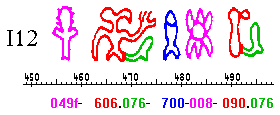
In 1998 the Rapa Nui Journal published an article by Jacques Guy where he sought to interpret the Santiago Staff in the light of Butinov and Knorozov's finding of a probable genealogy on the Small Santiago Tablet.
If Butinov and Knorozov's hypothesis is correct, then sign 76, Barthel's "phallus", Fischer's "copulation", is in reality a sign denoting patronymics, so that the Santiago Staff, where it occurs extremely frequently, consists almost entirely of personal names. According to oral tradition, some tablets consisted of ta'u (literally: "years," hence perhaps "annals"), which were lists of war coups, with their authors and victims, the latter called ika ("fish"). Consider the sequence below, found line 12, and which happens to contain Fischer's decipherment.

Sign 700 (position 475..480) resembles a fish. Perhaps there it means victim. Guy falls to the temptation and concludes: "It is difficult at this stage to resist the temptation of a partial decipherment of that sequence: "Killed (700): So-and-so (8) son of So-and-So (90.76)". The Santiago Staff, then, would be a ta'u. This hypothesis is congruent with the physical nature and reported origin of the staff [it was claimed by Dutroux-Bornier to have belonged to an ariki ("king")]. It is natural and reasonable to expect a chieftain's baton engraved with writing to contain either his genealogy or the war exploits of his tribe." (Probable Nature and Contents of the Santiago Staff. Rapa Nui Journal, 12/4:109).